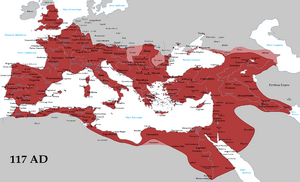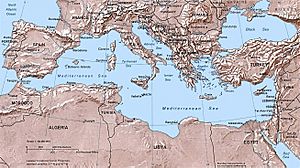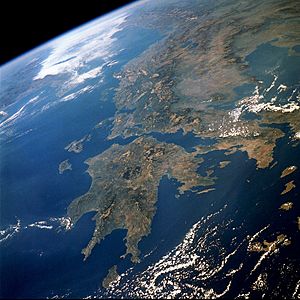Mediterranean Sea facts for kids
The Mediterranean Sea is the body of water that separates Europe, Africa and Asia.
The Mediterranean Sea is connected to the Atlantic Ocean by a narrow passage called the Strait of Gibraltar. It is between the southern tip of Spain and northern Morroco. It is almost completely surrounded by land, on the north by Europe, on the south by North Africa, and on the east by the Middle East. It covers around 2.5 million km² (965 000 mi²).
To the east it connects to the Sea of Marmara and the Black Sea, by the Dardanelles and the Bosporus. The Sea of Marmara is often thought to be a part of the Mediterranean Sea. The Black Sea is much bigger than the Dardanelles, and is generally not considered part of the Mediterranean.
The 163 km (101 mi) long man-made Suez Canal in the southeast connects the Mediterranean Sea to the Red Sea. The canal is between Egypt and the Sinai peninsula. It was built by the French Compagnie Universelle du Canal Maritime de Suez from 1859 to 1869 against the British government.As a sea around which some of the most ancient human civilizations were arranged
Contents
History

Some of the most ancient human civilisations were made around the Mediterranean Sea, so it has had a large influence on the history and ways of life of these cultures. It provided a way of trade, colonization and war, and was the basis of life (like fishing and catching other seafood) for many communities throughout the ages. The combination of similarly shared climate, geology and access to a common sea has led to lots of historical and cultural connections between the ancient and modern societies around the Mediterranean.
Above all, it was the superhighway of transport in ancient times. It allowed for trade and cultural exchange between peoples of the region — Phoenicians, Egyptians, Carthaginians, Greeks, Romans, and the Middle East (Arab/Persian/Semitic) cultures.
The history of the Mediterranean is important in understanding the origin and development of Western civilization. In modern times, the Mediterranean was the location of many battles at sea during World War II and control over it was important for defeating the Axis Powers, Nazi Germany and Fascist Italy. Today the Mediterranean Sea still connects the economies of Europe, North Africa, and the Middle East as it did in ancient times. The european migrant crisis has resulted in many refugees drowning in the Mediterranean Sea.
Oceanography
Being nearly landlocked affects the Mediterranean Sea's properties. Tides are limited by the narrow connection with the Atlantic Ocean. The water is saltier, partly because of evaporation. The Mediterranean has a deep blue color.
Evaporation greatly exceeds precipitation and river runoff in the Mediterranean, a fact that is central to the water circulation within the basin. Evaporation is especially high in its eastern half, causing the water level to decrease and salinity to increase eastward. This pressure gradient pushes relatively cool, low-salinity water from the Atlantic across the basin; it warms and becomes saltier as it travels east, then sinks in the region of the Levant and circulates westward, to spill over the Strait of Gibraltar. Thus, seawater flow is eastward in the Strait's surface waters, and westward below; once in the Atlantic, this chemically distinct "Mediterranean Intermediate Water" can persist thousands of kilometers away from its source.
Images for kids
-
The Battle of Lepanto, 1571, ended in victory for the European Holy League against the Ottoman Turks.
-
The bombardment of Algiers by the Anglo-Dutch fleet in support of an ultimatum to release European slaves, August 1816
-
Approximate extent of the Mediterranean drainage basin (dark green). Nile basin only partially shown
-
Alexandria, the largest city on the Mediterranean
-
Barcelona, the second largest metropolitan area on the Mediterranean Sea (after Alexandria) and the headquarters of the Union for the Mediterranean
-
The Acropolis of Athens with the Mediterranean Sea in the background
-
The ancient port of Jaffa (now in Tel Aviv-Yafo), from which the biblical Jonah set sail before being swallowed by a whale
-
Catania, Sicily, Italy, with Mount Etna in the background
-
Positano, Italy, Tyrrhenian Sea
-
Sarandë, Albania, stands on an open-sea gulf of the Ionian sea in the central Mediterranean.
-
The thermonuclear bomb that fell into the sea recovered off Palomares, Almería, 1966
-
Stromboli volcano in Italy
-
The reticulate whipray is one of the species that colonised the Eastern Mediterranean through the Suez Canal as part of the ongoing Lessepsian migration.
-
Port of Trieste
-
Kemer Beach in Antalya on the Turkish Riviera (Turquoise Coast). In 2019, Turkey ranked sixth in the world in terms of the number of international tourist arrivals, with 51.2 million foreign tourists visiting the country.
-
Coast of Alexandria, view From Bibliotheca Alexandrina, Egypt
-
Sardinia's south coast, Italy
-
View of Neum, Bosnia and Herzegovina
-
Paphos, Cyprus
-
Burj Islam Beach, Latakia, Syria
-
A view of Raouché off the coast of Beirut, Lebanon
-
A view of Haifa, Israel
-
Europa Point, Gibraltar
See also
 In Spanish: Mar Mediterráneo para niños
In Spanish: Mar Mediterráneo para niños

















































